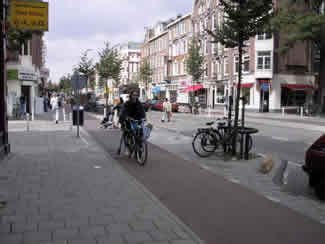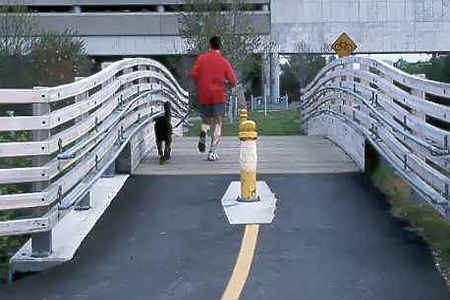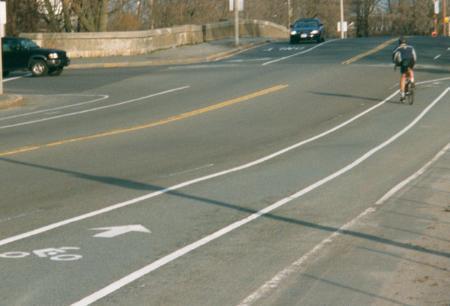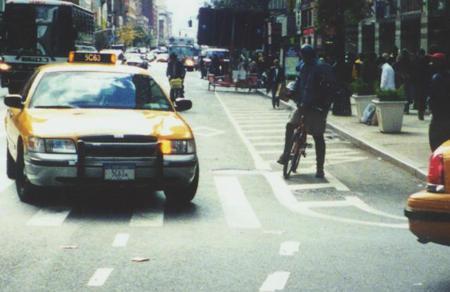“Inferior legal status for cyclists turns cyclists into the lepers of the roads.”
– John Forester, Effective Cycling
This report guides readers in understanding bicycle laws. It helps to clarify the legal treatment of bicyclists in traffic. The analysis and recommendations can assist those interested in reforming state vehicle codes. It is also a resource for anyone who wants to learn how bicyclists are treated under traffic laws.
Laws related to bicycling from all 50 U.S. states were reviewed for this report. The official state websites provided most of the traffic codes. Local governments also have thousands of traffic ordinances. The rules in these local codes may not be consistent with state law. The information can also be used to reform local laws.
Why Traffic Law Matters
The highway codes in every U.S. state treat cyclists as drivers of vehicles. However, many states have added unnecessary and prejudicial rules that apply only to cyclists. Such rules create the false public idea that cyclists are not drivers. The law should not reflect the belief that cyclists have inferior rights. When traffic laws are fair, judges, police, and the public are more likely to treat cyclists as vehicle drivers.
There are several reasons why traffic laws for cyclists should be free of prejudice. First, statutes are often the basis for “safe bicycling” information given by police. Second, the wording affects law enforcement behavior. Third, statutes are a factor in determining negligence in civil proceedings after crashes. The law should not require more equipment or caution than is necessary for safe operation.
Statutes should also be clear and easy to interpret. It should be easy to understand the law without needing legal expertise.
Cyclists and the Traffic Law
There is no single national traffic law in the U.S. Each state has different laws. The Uniform Vehicle Code (UVC) is a model law for states to adopt. Most states have adopted a version of this code.
Vehicle codes regulate people, not vehicles. They regulate pedestrians and drivers. Drivers are people operating any wheeled vehicle on roadways. This includes both non-motorized and motor vehicles. All drivers must obey all laws for drivers. Drivers of motor vehicles must obey additional rules.
Cyclists riding on a roadway or shoulder are drivers of vehicles. They must follow all laws for drivers. Cyclists walking with their bicycles are considered pedestrians.
In every state, cyclists have the same duties and privileges as motorists. The general principles of traffic operation are designed to reduce collisions. They also allow for faster travel. Cyclists function well within this system.
Motor vehicle operators must meet additional requirements that cyclists do not. These include driver’s licenses, vehicle registration, and insurance. State laws should clarify that these special rules apply only to motor vehicles.
Almost all states define a cyclist as a driver of a vehicle. This is done by explicitly stating that cyclists have the rights and duties of drivers. A common version of this rule is overly restrictive. It mentions only “upon a roadway,” which does not include the shoulder. A clear law would state that a cyclist has all the rights and duties of any other vehicle driver.
Uniformity of Traffic Laws
State laws generally take precedence over local laws. Many states have specific provisions for this. Statewide uniformity is good for cyclists. It prevents local governments from passing rules that are unfriendly to cyclists.
The UVC permits local governments to regulate the “operation of bicycles.” This can be a license to enact local rules that apply only to bicycles. This can lead to unwarranted rules and the exclusion of bicycles from certain roads.
State laws also allow for local registration of bicycles. Mandatory registration rules have been used to harass cyclists in the past.
Defining “Bicycle”
Most states define the word bicycle in their traffic laws. The definition should exclude scooters and unicycles. It should not exclude small-wheeled or adult tricycles. Some current state laws are overly restrictive.
A recommended wording for the definition of “bicycle” is: “Every vehicle propelled solely by pedals, operated by one or more persons, and having two or more wheels, except children’s tricycles.”
Bicycle-Specific Rules in General Driving Laws
All general driving rules apply to bicycles. However, a few of these rules need to be updated to account for bicycles.
Right Turn Hand Signal: The right arm signal for a right turn is more intuitive for cyclists. Many states now permit this signal.
Continuous Signal: Many states require a continuous turn signal for a certain distance. This can be dangerous and difficult for a cyclist. Many states now exempt cyclists from this requirement.
Sidewalk Use: A person walking a bicycle is considered a pedestrian. Cyclists are generally safer on the roadway. However, some states permit sidewalk bicycling in certain situations. They may require cyclists to yield to pedestrians.
Manner of Making Left Turns: Cyclists and motorcyclists do not occupy an entire lane width. The rule for making a left turn should be clarified. The turn should be made from the left-most portion of the road. This is not just the left-most lane.
Following Too Closely: The standard language on tailgating should apply only to motor vehicles. If applied to bicycles, it could be interpreted as prohibiting riding in a group for drafting.
Parking on Sidewalks: Many states prohibit parking on sidewalks. In states where bicycles are vehicles, this applies to bicycles. States should permit bicycles to park on sidewalks, but with restrictions. The restrictions should ensure they do not block pedestrians.
Racing and Impeding Traffic: Some states have rules on racing that could apply to any group of cyclists. These rules should be modified to apply only to motor vehicles. Similarly, rules prohibiting impeding traffic should not apply to bicycles.
Slow-Moving Vehicle Rule: This rule requires slow-moving vehicles to keep to the right. This rule is sufficient. It is more effective than a separate “bicycles keep to the far right” rule.
Bicycle Equipment
Night Visibility from the Front: All states require a headlight after dark. The required visibility distance varies. A generator light should be permitted.
Night Visibility from the Rear: Most states require a rear reflector. Some states require a rear red light. All states specify a minimum visibility distance for reflectors.
Brakes: Every state has a rule about braking. Some require the brake to cause the rear wheel to skid. Others specify a stopping distance.
Helmets: Some states have laws requiring helmets for children. No U.S. state has a mandatory helmet law for all adult cyclists.
Discriminatory Rules
Most states have adopted discriminatory rules. These are rules of bicycle operation that do not apply to other vehicles. These rules are unnecessary and can be dangerous. They encourage cyclists to deviate from traffic rules. They also encourage others to treat cyclists differently.
Bicycles to the Far Right Rule: Most states require cyclists to keep to the far right. This rule is redundant and prejudicial.
Mandatory Bike Lane Use: Some states require cyclists to use a bike lane if one is present. Most of these rules have exceptions.
Mandatory Shoulder or Sidepath Use: A few states require cyclists to use the shoulder or a sidepath. Many states have repealed these rules because sidepaths are often more dangerous.
Number of Riders Abreast: Most states have a rule about riding abreast. Many permit riding two abreast unless traffic is impeded. Some require single-file riding.
Left Turn Prohibition: Some states allow signs to prohibit cyclists from making a normal left turn. This is discriminatory. It is impossible to predict when a vehicular turn is not safe.
Expressway Prohibition: All states prohibit cyclists on at least some express highways. This rule should be re-examined. It should be based on safety rather than a general ban.
Special Rules for Motorists
A few states have adopted special rules for how motorists should act around cyclists. Some of these are helpful. They include laws requiring a safe passing distance. They also include laws requiring motorists to use due care to avoid collisions.
Some states, such as Minnesota, have clarified how a motorist should turn right. They must merge into the bike lane before the turn. This helps reduce confusion.
Overall, a lack of bicycle-specific laws is a good thing. It means cyclists are treated the same as any other vehicle operator. Changes are needed to remove discriminatory rules and clarify general traffic laws.



